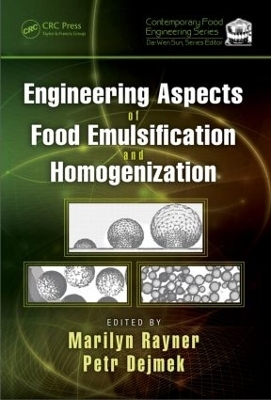
Engineering Aspects of Food Emulsification and Homogenization
Crc Press Inc (Verlag)
978-1-4665-8043-5 (ISBN)
This book summarizes the present understanding of the involved physical–chemical processes as well as specific information about the limits and possibilities for the different types of emulsifying equipment. It covers colloidal chemistry and engineering aspects of emulsification and discusses high-energy and low-energy emulsification methods. The chapters highlight low-energy emulsification processes such as membrane emulsification that are now industrially feasible. Dramatically more energy-efficient processes are being developed, and this book clarifies their present limitations, such us scale-up and achievable droplet sizes.
The present literature on emulsification is, to a large degree, influenced by the division between physical chemistry, fluid dynamics, and chemical engineering. Written by experts drawn from academia and industry, this book brings those areas together to provide a comprehensive resource that gives a deeper understanding of emulsification and homogenization in food product development.
Marilyn Rayner graduated with a bachelor’s degree in biological engineering, with a food engineering specialization from the University of Guelph, Canada, in 1999 and earned her PhD in food engineering from Lund University in 2005 on modeling droplet formation in membrane emulsification. Dr. Rayner was awarded the Food Engineer of the Year 2005 from the Institution of Mechanical Engineers, United Kingdom, for her work on predicting the effects of pore geometry on droplet size in membrane emulsification processes. Since then, Dr. Rayner has worked in the area of multiphysics modeling, unit operation, interfacial phenomena, and particlestabilized emulsions, and is currently associate professor in food engineering at Lund University and the founder of two spin-off enterprises in the area of membrane design and particle-stabilized formulations. Petr Dejmek, a native Czech, graduated as a process engineer from the Technical University in Aachen, Germany, and earned his PhD in food engineering at Lund University, Sweden. After 10 years with Alfa Laval companies in Sweden and Denmark, Dr. Dejmek returned to Lund University to eventually hold a research chair as professor of dairy technology, full professor of food engineering, and department head. As a visiting professor, Dr. Dejmek worked at Tokyo University, ENSIA Massy, Japanese National Food Research Institute, University of Wisconsin, and University of California, Davis. Dr. Dejmek was one of the editors of the International Dairy Journal for 10 years. He is the author of more than 100 publications on varying topics on food technology and engineering and the founder of two spin-off companies.
Emulsion Fundamentals. Scales and forces. Emulsion formation and stability (droplet formation, recoalescence, creaming, flocculation). Molecule stabilized emulsions. Particle stabilized emulsions. High Energy Processes. Droplet breakup in high pressure homogenizer. High pressure homogenizer design. High pressure homogenisation with micro structured systems. Rotor/stator devices. Ultrasound emulsification. Low Energy Processes. Microchannel devices. Sieve devices. Shirasu Porous Glass Membrane Emulsification.
| Reihe/Serie | Contemporary Food Engineering |
|---|---|
| Zusatzinfo | 46 Tables, black and white; 130 Illustrations, black and white |
| Verlagsort | Bosa Roca |
| Sprache | englisch |
| Maße | 156 x 234 mm |
| Gewicht | 616 g |
| Themenwelt | Technik ► Lebensmitteltechnologie |
| ISBN-10 | 1-4665-8043-7 / 1466580437 |
| ISBN-13 | 978-1-4665-8043-5 / 9781466580435 |
| Zustand | Neuware |
| Informationen gemäß Produktsicherheitsverordnung (GPSR) | |
| Haben Sie eine Frage zum Produkt? |
aus dem Bereich


